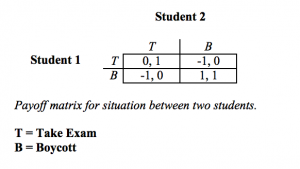Gaming the System: A Game Theory Approach to Grading on a Curve
URL: https://www.insidehighered.com/news/2013/02/12/students-boycott-final-challenge-professors-grading-policy-and-get
If you are a student at Cornell University, it is highly likely that you are very familiar with the concept of grading on a curve. Many college classes at universities around the world use this approach in order to grade assignments in a predictable and consistent way by comparing students’ work to their peers’. Grading on a curve can be approached in several different ways, however the most popular method is to give a 100% on an assignment to the person that achieves the most points overall out of all of the assignments submitted, even if they did not get a perfect score, and then assign grades to other students based on percentages of that grade to those that fell below the highest achieved grade.
Professor Fröhlich, a computer science professor at John’s Hopkins University used a curved grading approach similar to the one outlined above in one his classes’ final exams. His policy stated that the highest achieved grade on the exam would get a 100%. However, at the end of the semester, he was in for a bit of a surprise. To his dismay, students decided to push this curved grading policy to the limits by collectively boycotting the final exam in the hopes that everyone would not take it and would get a 0. This seems crazy, however according to the grading policy, if the highest grade achieved on the exam by everyone in the class was a 0, then effectively everybody should get a 100 and an A on the exam.
However, boycotting an exam in a class as large as Professor Fröhlich’s takes a lot of work to pull off. There were several students behind the planning of the boycott that organized everything. In order to determine the reasoning behind these students’ motivations, and how they planned for unexpected turns along the way, we are going to look at the situation through the lens of game theory and Nash equilibriums, both of which we have studied extensively in INFO 2040. Surprisingly enough, one of the students planning the boycott even took the game theory approach to the situation into consideration himself while planning the boycott. Andrew Kelly, one of the student leaders in the boycott explains how “if you can walk in with 100 percent confidence of answering every question correctly, then your payoff would be the same for either decision. Just consider the impact on your other exam performances if you studied for the final at the level required to guarantee yourself 100. Otherwise, it’s best to work with your colleagues to ensure a 100 for all and a very pleasant start to the holidays.”
On the day of the final exam, according to Professor Fröhlich, “the students refused to come into the room and take the exam, so we sat there for a while: me on the inside, they on the outside. After about 20-30 minutes I would give up…. Then we all left.” Interestingly, the students waited outside the rooms to make sure that all the other students honored the boycott, and were poised to go in if somebody mad the bold choice to disobey. However, nobody made the decision to do so, and the boycott when through successfully without a hitch.
Using Andrew Kelly’s reasoning explained above lets construct a payoff matrix for a hypothetical situation between two students in the class showing their decision-making strategies. The payoff matrix below shows both of their strategies on whether or not they think it is better to boycott or take the exam.
As you can see from the payoff matrix above, we can calculate two Nash equillibria in this situation: equilibrium #1 is that neither of the students takes the test (B, B), and equilibrium #2 is that both of the students take the test (T, T). Both equilibria depend on what each believes the other will do.
When looking at the class as a whole, if it is believed that all students will participate in the boycott with 100 percent certainty, then everyone should boycott and not take the exam according to the Nash equilibrium #1. However, if anyone suspects that even one person will not participate in the boycott, then at least someone will break the boycott and take the exam and everyone else will update their choices and decide whether or not to take the exam according to Nash equilibrium #2.
In the end, amazingly the professor decided to honor his original grading system policy and gave everyone an A on the exam, even though everyone essentially got a 0. I bet he never expected students would take advantage of his policy as they did in this situation. According to the Inside Higher Ed article, the professor seems to have wised up and planning on modifying his grading scheme going forward to prevent this from happening again in future semesters.

